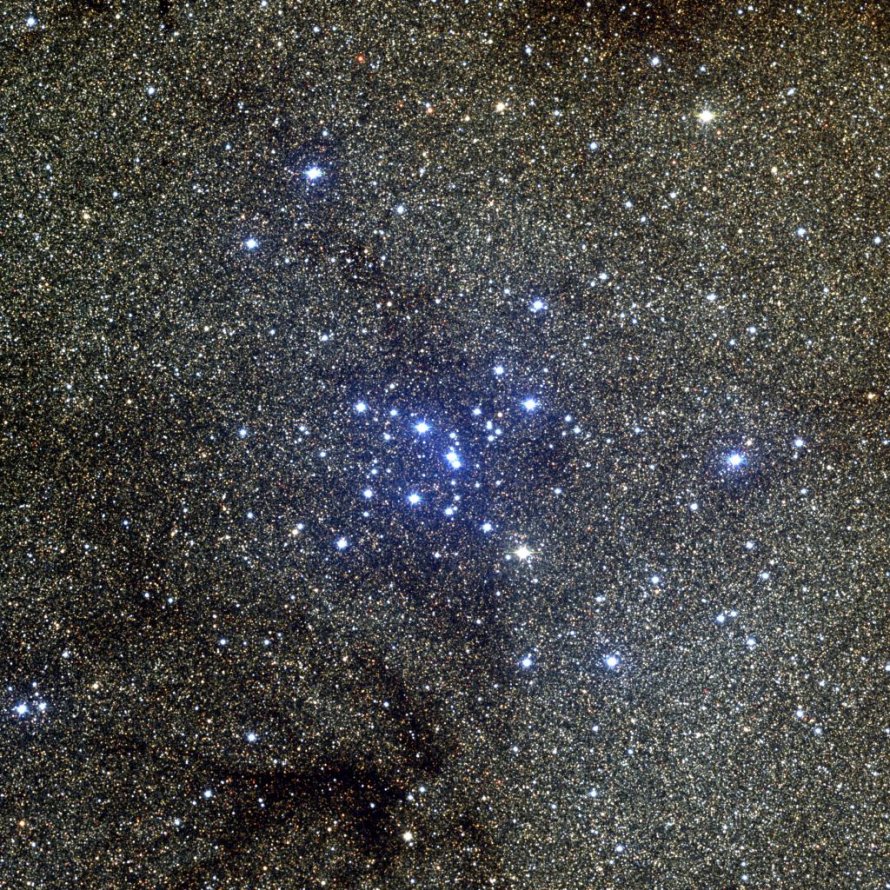M7 (NGC 6475) - Ptolemy Cluster
Messier 7 (NGC 6475), also known as the Ptolemy Cluster, is an open cluster located in the constellation Scorpius, in the Orion Arm of the Milky Way Galaxy in the Local Group of galaxies. M7 is 980 light years away from Earth.
M7 is best viewed during mid-summer, is magnitude 3.3, and can be viewed with naked eye. M7 is 80' in apparent size. For reference, the full moon is 30'.
Observing difficulty: Easy
- Name:
- Ptolemy Cluster
- Type:
- open cluster
- Constellation:
- Scorpius
- NGC or IC:
- NGC 6475
- Magnitude:
- 3.3
- Viewing:
- naked eye
- Size:
- 80'
- Distance (light years):
- 980 LY
- RA:
- 17h 53.9m
- Dec:
- -34 49'
- Season:
- mid-summer
- Milky Way location:
- Orion Arm
- Galaxy group:
- Local Group
- Messier Marathon #:
- 87
* The naked eye can see up to magnitude ~7-8 objects under ideal dark sky conditions.
A Gleaming Gem in Scorpius
Messier 7 (M7), also known as the Ptolemy Cluster, is a vibrant open cluster located in the constellation Scorpius. Renowned for its luminous stars and relative proximity, M7 offers an exciting opportunity to study star formation and cluster dynamics. This article delves into the key technical aspects of M7, spanning its discovery, physical properties, stellar composition, and scientific significance.
Discovery and Observation
M7 was first documented by the ancient Greek astronomer Claudius Ptolemy in 130 AD, hence its alternative name the Ptolemy Cluster. Charles Messier later cataloged it in 1764. Positioned approximately 980 light-years away, M7 is one of the closest and most conspicuous open clusters to Earth, making it a captivating object for both amateur stargazers and professional astronomers.
Physical Characteristics
M7 spans an area of the sky about 1.3 degrees in diameter, corresponding to an actual size of approximately 25 light-years across. The cluster consists of about 80 stars, the majority of which are arranged in a core region approximately 12 light-years in diameter. Interestingly, M7 also displays a pronounced mass segregation, with its most massive stars located in the cluster center, a typical feature for dynamically evolved stellar systems.
Stellar Composition
With an estimated age of around 200 million years, M7 is a relatively young cluster. Its members include a diverse assortment of spectral types, mainly consisting of hot, luminous B-type and A-type stars. However, it also hosts a number of cooler G-type and K-type stars. The cluster's brightest star, a K-type giant, shines with a magnitude of 5.6. The abundance of heavy elements, or metallicity, in the stars of M7 is comparable to that of our Sun, a reflection of the similar composition of the interstellar medium from which they formed.
Unique Features and Phenomena
A striking feature of M7 is its richness in solar-type stars, providing an exciting playground for the search for extrasolar planets. Moreover, M7's conspicuousness and its location near the galactic plane make it an excellent target for studying the Milky Way's structure and the distribution of interstellar dust along the line of sight.
Scientific Significance
The proximity, age, and composition of M7 offer a facinating opportunity for scientists. Studying M7 allows for a detailed understanding of the physical processes occurring in open star clusters, from star formation to dynamical evolution. Furthermore, M7 serves as an excellent reference point for calibrating distance measures and studying the Milky Way's structure and star formation history.
Apparent Magnitude and Distance
Messier 7 has an apparent magnitude of approximately 3.3, making it one of the brightest open clusters observable from Earth. In fact, its brightness is such that it is easily visible to the naked eye under good viewing conditions. The cluster is located at a distance of about 980 light-years from us, which, on a cosmic scale, is relatively close.
Finding and Observing Messier 7
The Ptolemy Cluster is located in the "stinger" of Scorpius, the scorpion, near the boundary with the constellation Sagittarius. For observers in the Northern Hemisphere, the cluster is visible low in the southern sky during the summer months, while it appears high in the sky for those in the Southern Hemisphere.
Given its brightness, M7 can be spotted with the naked eye as a nebulous patch in the sky under clear, dark conditions. Using binoculars or a small telescope will resolve the cluster into its individual stars, and under good viewing conditions, observers can discern a broad range of star colors, from the blue-white of the hot B-type stars to the yellow of the cluster's brightest star.



